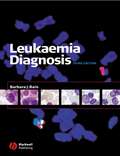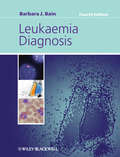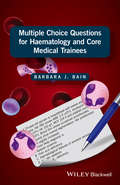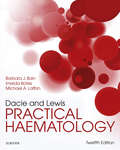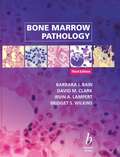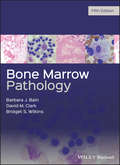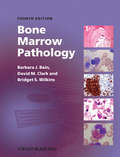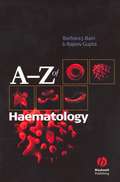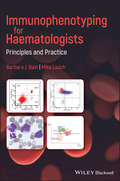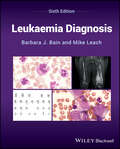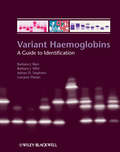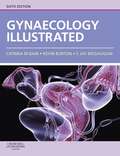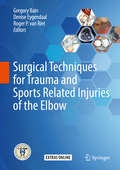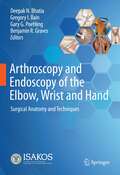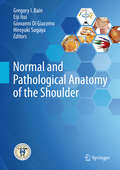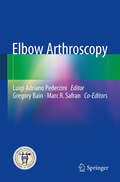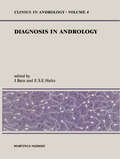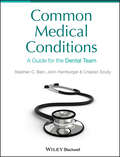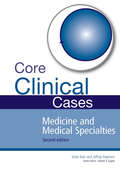- Table View
- List View
Leukaemia Diagnosis
by Barbara J. BainNow in its third edition Leukaemia Diagnosis has been completely revised and updated throughout to include the latest developments in the fields of haematology and oncology. Written by Barbabra Bain, an acclaimed haematologist and morphologist, Leukaemia Diagnosis is a highly practical guide and reference source, which reflects the latest changes in the fields of morphology, cytochemistry, immunophenotyping, cytogenetics and molecular genetics. The third edition of Leukaemia Diagnosis includes: Over 180 superb four-colour photographs of normal cells and abnormal variants The latest WHO leukaemia classification guidelines
Leukaemia Diagnosis
by Barbara J. BainUP-TO-DATE PRACTICAL GUIDE TO LEUKAEMIA DIAGNOSIS Written by a renowned expert this practical guide had been fully revised and updated. The book covers recent advances in the fields of immunophenotyping, cytogenetics and molecular genetics. It illustrates how laboratory techniques are used for the diagnosis and classification of leukaemia and includes images of abnormal cells to aid diagnosis. This fourth edition: Incorporates the recommendations of the 2008 WHO Classification of Tumours of Haematopoietic and Lymphoid Tissues Includes 300 high quality full colour digital images of abnormal cells in leukaemia and lymphoma - 50 of which are completely new Every haematologist and haematopathologist should keep a copy close at hand for quick reference.
Multiple Choice Questions for Haematology and Core Medical Trainees
by Barbara J. BainWritten to help haematology and general medical trainees evaluate their own knowledge, and particularly useful for those preparing for the Part 1 examination of the Royal College of Pathologists. This exam-centered book will also be of use to core medical trainees preparing for the examinations of the Royal College of Physicians and the Royal Australasian College of Physicians and to haematology and general medicine trainees in other countries where methods of examination are similar. The 150 questions are presented in two formats, Single Best Answer and Extended Matching Question, and comes complete with detailed feedback and, when appropriate, relevant references are given for each question so that those who select the wrong answer will understand why another answer is better. Quick reference question book, ideal for examination preparation Includes 50 SBA questions, ideal for the Part 1 and Part 2 MRCP examinations, which although having a general medical slant, are also appropriate for haematology specialist trainees Includes 70 SBA multiple choice questions appropriate for haematology specialist trainees but also useful to core medical trainees Includes 30 EMQs suitable for those taking Part 1 of the FRCPath examination Questions come complete with fully referenced answers and discussion points This book provides an educational tool for training as well as an ideal way to prepare for examinations and is also of value to those who examine in haematology and haematopathology.
Multiple Choice Questions for Haematology and Core Medical Trainees
by Barbara J. BainWritten to help haematology and general medical trainees evaluate their own knowledge, and particularly useful for those preparing for the Part 1 examination of the Royal College of Pathologists. This exam-centered book will also be of use to core medical trainees preparing for the examinations of the Royal College of Physicians and the Royal Australasian College of Physicians and to haematology and general medicine trainees in other countries where methods of examination are similar. The 150 questions are presented in two formats, Single Best Answer and Extended Matching Question, and comes complete with detailed feedback and, when appropriate, relevant references are given for each question so that those who select the wrong answer will understand why another answer is better. Quick reference question book, ideal for examination preparation Includes 50 SBA questions, ideal for the Part 1 and Part 2 MRCP examinations, which although having a general medical slant, are also appropriate for haematology specialist trainees Includes 70 SBA multiple choice questions appropriate for haematology specialist trainees but also useful to core medical trainees Includes 30 EMQs suitable for those taking Part 1 of the FRCPath examination Questions come complete with fully referenced answers and discussion points This book provides an educational tool for training as well as an ideal way to prepare for examinations and is also of value to those who examine in haematology and haematopathology.
Dacie and Lewis Practical Haematology E-Book
by Barbara J. Bain Imelda Bates Mike A LaffanFor more than 65 years, this best-selling text by Drs. Barbara J. Bain, Imelda Bates, and Mike A. Laffan has been the worldwide standard in laboratory haematology. The 12th Edition of Dacie and Lewis Practical Haematology continues the tradition of excellence with thorough coverage of all of the techniques used in the investigation of patients with blood disorders, including the latest technologies as well as traditional manual methods of measurement. You’ll find expert discussions of the principles of each test, possible causes of error, and the interpretation and clinical significance of the findings.A unique section on haematology in under-resourced laboratories. Ideal as a laboratory reference or as a comprehensive exam study tool. Each templated, easy-to-follow chapter has been completely updated, featuring new information on haematological diagnosis, molecular testing, blood transfusion- and much more. Complete coverage of the latest advances in the field. An expanded section on coagulation now covers testing for new anticoagulants and includes clinical applications of the tests.
Bone Marrow Pathology
by Barbara J. Bain David M. Clark Irvin A. Lampert Bridget S. WilkinsWritten by one of the world's leading haematologists, and three renowned histopathologists, Bone Marrow Pathology provides a comprehensive guide to the diagnosis of bone marrow disease. Now in its Third Edition, the text has been extensively revised and rewritten to reflect the latest advances in the field. Features: An extremely practical, up-to-the-minute text incorporating the new WHO classification of haematopoietic malignancies A comprehensive text written with great precision and clarity of style Incorporates a new section 'Problems and Pitfalls' - a unique section that will aid the working pathologist faced with a difficult situation An important text for the haematologist, histopathologist and haematopathologist with equal weight given to peripheral blood, aspirate, trephine biology and specialized techniques Extensively illustrated with many of the photographs being of paraffin-embedded sections Combines all the techniques now applied to bone marrow diagnosis, including immunocytochemistry, flow cytometery, immunohistochemistry and the diagnostic role of cytogenetic and molecular genetic analysis
Bone Marrow Pathology
by Barbara J. Bain David M. Clark Bridget S. WilkinsBone Marrow Pathology has been extensively revised to reflect the significant advances which have occurred in the application of cytogenetics and in particular, molecular genetics in the diagnosis, classification and understanding of haematological disorders. This comprehensive book not only provides information on all common disease entities, but also covers rare disorders in which bone marrow examination is useful. It is designed as a practical resource with "problems and pitfalls" highlighted throughout to aid laboratory diagnosis.
Bone Marrow Pathology
by Barbara J. Bain David M. Clark Bridget S. WilkinsBone Marrow Pathology has been extensively revised to reflect the significant advances which have occurred in the application of cytogenetics and in particular, molecular genetics in the diagnosis, classification and understanding of haematological disorders. This comprehensive book not only provides information on all common disease entities, but also covers rare disorders in which bone marrow examination is useful. It is designed as a practical resource with "problems and pitfalls" highlighted throughout to aid laboratory diagnosis.
Bone Marrow Pathology
by Barbara J. Bain David M. Clark Bridget S. WilkinsBone Marrow Pathology has been extensively revised to reflect the significant advances which have occurred in the application of cytogenetics and in particular, molecular genetics in the diagnosis, classification and understanding of haematological disorders. This comprehensive book not only provides information on all common disease entities, but also covers rare disorders in which bone marrow examination is useful. It is designed as practical resource with ‘Problems and Pitfalls’ sections throughout to aid laboratory diagnosis. This fourth edition: Incorporates the recommendations of the 2008 WHO Classification of Tumours of Haematopoietic and Lymphoid Tissues Covers key diagnostic techniques such as flow cytometric immunophenotyping, immunohistochemistry and cytogenetic and molecular genetic analysis Includes new diagnostic algorithms and summary boxes Contains 550 colour illustrations including high-quality digital photomicrographs Haematologists and histopathologists will find this book an invaluable desktop reference when performing daily blood and bone marrow investigations.
Bone Marrow Pathology
by Barbara J. Bain David M. Clark Bridget S. WilkinsBone Marrow Pathology has been extensively revised to reflect the significant advances which have occurred in the application of cytogenetics and in particular, molecular genetics in the diagnosis, classification and understanding of haematological disorders. This comprehensive book not only provides information on all common disease entities, but also covers rare disorders in which bone marrow examination is useful. It is designed as practical resource with ‘Problems and Pitfalls’ sections throughout to aid laboratory diagnosis. This fourth edition: Incorporates the recommendations of the 2008 WHO Classification of Tumours of Haematopoietic and Lymphoid Tissues Covers key diagnostic techniques such as flow cytometric immunophenotyping, immunohistochemistry and cytogenetic and molecular genetic analysis Includes new diagnostic algorithms and summary boxes Contains 550 colour illustrations including high-quality digital photomicrographs Haematologists and histopathologists will find this book an invaluable desktop reference when performing daily blood and bone marrow investigations.
A - Z of Haematology
by Barbara J. Bain Rajeev GuptaA–Z of Haematology provides an essential "quick reference guide" to definitions covering the entire spectrum of haematology, from blood transfusion and coagulation through to recent advances in molecular haematology. It is the indispensable guide for all those practising or studying haematology including research scientists and biomedical scientists working in diagnostic laboratories. Scientists working in cytogenetics and immunophenotyping will also find it a valuable repository of relevant knowledge. A–Z of Haematology includes: Definitions cover the entire spectrum of haematology, from blood transfusion and coagulation through to molecular haematology Essential "quick reference guide" for all those practising or studying haematology Over 100 figures to explain and clarify difficult concepts Inclusion of all CD numbers and oncogenes to be encountered in daily practice Appendices of laboratory data and normal values included
Immunophenotyping for Haematologists: Principles and Practice
by Barbara J. Bain Mike LeachOffers clear and concise instruction on running, reporting and interpreting immunophenotyping studies Written by two well-known haematology educators and experts on the topic, Immunophenotyping for Haematologists contains an introduction to running, reporting and interpreting immunophenotyping studies. The book offers a unique approach to the topic by putting the focus on clinical and laboratory haematologists who are not routinely involved in running and reporting on immunophenotyping studies. Immunophenotyping using flow cytometry has become the method of choice in identifying and sorting cells within complex populations, for example, the analysis of immune or neoplastic cells in a blood sample. The text reviews the purpose and principles of immunophenotyping and includes an introduction and explanation of the principles and the role of immunophenotyping. The authors examine immunophenotypic characteristics of the disease groups commonly encountered and identify the features that differentiate malignant cells from normal cells. To enhance understanding, the book contains multiple choice and extended matching questions which integrates immunophenotyping with clinicopathological features and the results of other investigations to mimic everyday practice. This important book: Provides a concise introduction to running, reporting and interpreting immunophenotyping studies Contains a list of all the antibody specificities currently widely used in diagnosis and disease monitoring Presents an ideal reference for use in laboratories, including immunophenotyping laboratories Aids in the interpretation by covering immunophenotypic characteristics of commonly encountered disease groups Identifies the features that differentiate malignant cells from their normal counterparts Written for haematologists working in both laboratory and clinical haematology, Immunophenotyping for Haematologists is a much-needed reference for understanding and interpreting immunophenotyping studies.
Immunophenotyping for Haematologists: Principles and Practice
by Barbara J. Bain Mike LeachOffers clear and concise instruction on running, reporting and interpreting immunophenotyping studies Written by two well-known haematology educators and experts on the topic, Immunophenotyping for Haematologists contains an introduction to running, reporting and interpreting immunophenotyping studies. The book offers a unique approach to the topic by putting the focus on clinical and laboratory haematologists who are not routinely involved in running and reporting on immunophenotyping studies. Immunophenotyping using flow cytometry has become the method of choice in identifying and sorting cells within complex populations, for example, the analysis of immune or neoplastic cells in a blood sample. The text reviews the purpose and principles of immunophenotyping and includes an introduction and explanation of the principles and the role of immunophenotyping. The authors examine immunophenotypic characteristics of the disease groups commonly encountered and identify the features that differentiate malignant cells from normal cells. To enhance understanding, the book contains multiple choice and extended matching questions which integrates immunophenotyping with clinicopathological features and the results of other investigations to mimic everyday practice. This important book: Provides a concise introduction to running, reporting and interpreting immunophenotyping studies Contains a list of all the antibody specificities currently widely used in diagnosis and disease monitoring Presents an ideal reference for use in laboratories, including immunophenotyping laboratories Aids in the interpretation by covering immunophenotypic characteristics of commonly encountered disease groups Identifies the features that differentiate malignant cells from their normal counterparts Written for haematologists working in both laboratory and clinical haematology, Immunophenotyping for Haematologists is a much-needed reference for understanding and interpreting immunophenotyping studies.
Leukaemia Diagnosis
by Barbara J. Bain Mike LeachLeukaemia Diagnosis Authoritative reference on classifying and diagnosing leukaemia, with practical guidance on using various laboratory techniques included Leukaemia Diagnosis is a practical reference on the principles of leukaemia diagnosis and classification that illustrates and explains in a user-friendly way how different laboratory techniques are used to achieve an accurate interpretation. To aid in reader comprehension, over 300 high quality full colour digital images of abnormal cells in leukaemia and lymphoma are included, supplemented by histological, cytogenetic and immunophenotyping images. This newly revised and updated Sixth Edition includes recent developments, highlights the growing importance of molecular genetics, and incorporates the recent 5th edition of the WHO guidelines and the International Consensus Classification for leukaemia diagnosis and classification throughout the text. Information on cytogenetic and molecular genetic abnormalities in leukaemia is also included, along with characteristic immunophenotypic characteristics of different categories of leukaemia. Written by world-renowned authors in the field, Barbara Bain and Mike Leach, Leukaemia Diagnosis covers sample topics such as: The nature of leukaemia, cytology, cytochemistry, and the morphological classification of acute leukaemia, with an index of commonly used abbreviations Immunophenotyping and cytogenetic/molecular genetic analysis, and integration of morphological, immunophenotypic and genetic information with the WHO classifications Acute lymphoblastic leukaemia, acute leukaemia of ambiguous lineage, and the myelodysplastic syndromes and myelodysplastic/myeloproliferative neoplasms Chronic myeloid leukaemias, lymphoid leukaemias of mature B, T, and natural killer cells, and leukaemia diagnosis in resource-poor countries The Sixth Edition of Leukaemia Diagnosis is a highly valuable resource for trainee haematologists and laboratory scientists in haematology and related disciplines. The text also serves as a useful reference and teaching aid for those who already have expertise in this field.
Leukaemia Diagnosis
by Barbara J. Bain Mike LeachLeukaemia Diagnosis Authoritative reference on classifying and diagnosing leukaemia, with practical guidance on using various laboratory techniques included Leukaemia Diagnosis is a practical reference on the principles of leukaemia diagnosis and classification that illustrates and explains in a user-friendly way how different laboratory techniques are used to achieve an accurate interpretation. To aid in reader comprehension, over 300 high quality full colour digital images of abnormal cells in leukaemia and lymphoma are included, supplemented by histological, cytogenetic and immunophenotyping images. This newly revised and updated Sixth Edition includes recent developments, highlights the growing importance of molecular genetics, and incorporates the recent 5th edition of the WHO guidelines and the International Consensus Classification for leukaemia diagnosis and classification throughout the text. Information on cytogenetic and molecular genetic abnormalities in leukaemia is also included, along with characteristic immunophenotypic characteristics of different categories of leukaemia. Written by world-renowned authors in the field, Barbara Bain and Mike Leach, Leukaemia Diagnosis covers sample topics such as: The nature of leukaemia, cytology, cytochemistry, and the morphological classification of acute leukaemia, with an index of commonly used abbreviations Immunophenotyping and cytogenetic/molecular genetic analysis, and integration of morphological, immunophenotypic and genetic information with the WHO classifications Acute lymphoblastic leukaemia, acute leukaemia of ambiguous lineage, and the myelodysplastic syndromes and myelodysplastic/myeloproliferative neoplasms Chronic myeloid leukaemias, lymphoid leukaemias of mature B, T, and natural killer cells, and leukaemia diagnosis in resource-poor countries The Sixth Edition of Leukaemia Diagnosis is a highly valuable resource for trainee haematologists and laboratory scientists in haematology and related disciplines. The text also serves as a useful reference and teaching aid for those who already have expertise in this field.
Variant Haemoglobins: A Guide to Identification
by Barbara J. Bain Barbara Wild Adrian Stephens Lorraine PhelanVariant Haemoglobins – A Guide to Identification is based on the premise that any single diagnostic technique offers only a very provisional identification of a variant haemoglobin. In routine diagnostic practice two techniques are needed as a minimum, with the results being interpreted in the light of the clinical details, blood count, blood film and ethnic origin. This book covers 150 normal and variant haemoglobins that have been studied and carefully documented. Variant Haemoglobins has four introductory chapters followed by an invaluable atlas. The introductory chapters cover the genetics of haemoglobin synthesis the principles of tests employed for identification common haemoglobins of major clinical or diagnostic importance thalassaemias and related conditions The atlas section comprises 170 full colour pages in which each variant haemoglobin or combination of haemoglobins is illustrated by cellulose acetate electrophoresis at alkaline pH, agarose gel electrophoresis at acid pH, isoelectric focusing and one or more HPLC traces. For ease of reference, the atlas pages are arranged according to the retention time of each haemoglobin on HPLC, this becoming increasingly the primary technique employed in haemoglobin identification. Bringing a mix of necessary scientific expertise and clinical knowledge, each author has more than 30 years experience in the diagnosis of variant haemoglobins. Providing otherwise unavailable information, this unique and practical guide is illustrated with over 700 high quality colour digital images plus flow charts and line diagrams covers common and important haemoglobin variants, in addition to many rarer ones is an essential reference source for diagnosis in the haematology laboratory A remarkably useful book, Variant Haemoglobins will be valuable for haematopathologists, clinical and laboratory haematologists in practice and in training and all laboratory staff involved in haemoglobinopathy diagnosis.
Variant Haemoglobins: A Guide to Identification
by Barbara J. Bain Barbara Wild Adrian Stephens Lorraine PhelanVariant Haemoglobins – A Guide to Identification is based on the premise that any single diagnostic technique offers only a very provisional identification of a variant haemoglobin. In routine diagnostic practice two techniques are needed as a minimum, with the results being interpreted in the light of the clinical details, blood count, blood film and ethnic origin. This book covers 150 normal and variant haemoglobins that have been studied and carefully documented. Variant Haemoglobins has four introductory chapters followed by an invaluable atlas. The introductory chapters cover the genetics of haemoglobin synthesis the principles of tests employed for identification common haemoglobins of major clinical or diagnostic importance thalassaemias and related conditions The atlas section comprises 170 full colour pages in which each variant haemoglobin or combination of haemoglobins is illustrated by cellulose acetate electrophoresis at alkaline pH, agarose gel electrophoresis at acid pH, isoelectric focusing and one or more HPLC traces. For ease of reference, the atlas pages are arranged according to the retention time of each haemoglobin on HPLC, this becoming increasingly the primary technique employed in haemoglobin identification. Bringing a mix of necessary scientific expertise and clinical knowledge, each author has more than 30 years experience in the diagnosis of variant haemoglobins. Providing otherwise unavailable information, this unique and practical guide is illustrated with over 700 high quality colour digital images plus flow charts and line diagrams covers common and important haemoglobin variants, in addition to many rarer ones is an essential reference source for diagnosis in the haematology laboratory A remarkably useful book, Variant Haemoglobins will be valuable for haematopathologists, clinical and laboratory haematologists in practice and in training and all laboratory staff involved in haemoglobinopathy diagnosis.
Gynaecology Illustrated E-Book
by Catrina Bain Kevin Burton Jay McGaviganEntirely revised and updated, with revision focus on:minimally invasive surgeryhormone-replacement therapyimaging techniques and equipmentrisk-managementNICE guidelinesmenorrhagia
Surgical Techniques for Trauma and Sports Related Injuries of the Elbow
by Gregory Bain Denise Eygendaal Roger P. van RietIn this book, leading international surgeons with expertise in the field provide cutting-edge information on the surgical techniques to treat sports and trauma injuries of the elbow. Indications for the different techniques are clearly explained, and practical aspects that allow safe and reproducible clinical outcomes are described. For the common procedures, a number of surgical technique options are presented, ensuring that the reader gains a broader perspective on this evolving surgical field. Throughout, valuable tips and tricks are highlighted that will assist both the experienced and the training surgeon in achieving maximum efficiency in their surgical practice. The book includes hundreds of illustrations, line diagrams, and clinical and cadaveric photographs to assist the reader in appreciating the principles of the clinical anatomy and the surgical techniques. Videos aid in understanding the finer points of the procedures. Surgical Techniques for Sports and Trauma Related Injuries of the Elbow is published in collaboration with ISAKOS. It will provide readers with a new comprehension of the topic and will be of value to students, physiotherapists, sports physicians, and orthopaedic surgeons.
Arthroscopy and Endoscopy of the Elbow, Wrist and Hand: Surgical Anatomy and Techniques
by Gregory I. Bain Deepak N. Bhatia Gary G. Poehling Benjamin R. GravesThis book explores the numerous recent advances in arthroscopic and endoscopic surgery of the smaller joints of the upper extremity – elbow, wrist, and hand. Providing readers with all necessary information, i.e. relevant surgical anatomy and a clear description of technical steps, it uniquely and comprehensively presents arthroscopic and endoscopic techniques of small joints in one publication.The procedures are subdivided according to the pathology (instability, fractures, etc.) or grouped by the region within the anatomical area and include the relevant anatomy, extensive cadaveric dissections, devices and instrumentation, surgical procedures, pearls and pitfalls. High-quality colour illustrations further simplify and complement the description of surgical techniques. Written by pioneers of these techniques, the book is designed to be an up-to-date reference resource for both new and advanced orthopaedic surgeons wanting to become familiar with these techniques.
Normal and Pathological Anatomy of the Shoulder
by Gregory I. Bain Eiji Itoi Giovanni Di Giacomo Hiroyuki SugayaThis cutting-edge monograph on advanced clinical anatomy and pathoanatomy of the shoulder, written by the world’s leading authors, reflects recent significant advances in understanding of anatomy and pathology. It is beautifully illustrated with exquisite photographs of anatomical specimens, and images from arthroscopy, histology, and radiology complete the picture. The accompanying text brings out the clinical, biomechanical, and functional relevance and focuses on aspects important to the high-performance athlete. In addition, the book closely assesses how each component of the normal anatomy responds to trauma, disease, and degeneration. The finer points of the pathoanatomy are demonstrated with clinical cases, histology, radiology, arthroscopy, and open surgery. The text details how the pathoanatomy affects the patient presentation, clinical examination, and imaging. It is also explained how the pathology affects the natural history and the outcome of physical therapy and influences recommendations for surgical treatments. This book will be of immense value both to trainees and to specialists who manage disorders of the shoulder, including orthopedic surgeons, sports physicians, and physiotherapists. It will also be of great interest to anatomists and pathologists.
Elbow Arthroscopy
by Gregory Bain Marc R. SafranThis book, which derives from an initiative of the Education Committee of The International Society of Arthroscopy, Knee Surgery and Orthopaedic Sports Medicine (ISAKOS), addresses all aspects of elbow arthroscopy. Anatomy is thoroughly introduced, referencing safe portals and describing techniques to minimize risk of complications. Subsequent chapters focus on the use of arthroscopy in a range of conditions, including osteochondritis dissecans, stiff elbow, epicondylitis, elbow instability, and elbow fractures. Guidance is provided on diagnosis and indications for arthroscopy, and arthroscopic technique is clearly detailed. A key chapter describes complications and how to avoid them. The authors are experts and pioneers in the field from North America, Australia, and Europe who have in common the ability to teach complex procedures in a simple way. This book will be an invaluable aid for the developing surgeon and an excellent reference for the experienced surgeon.
Diagnosis in Andrology (Clinics in Andrology #4)
by J. Bain E. S. E. HafezDespite the increasing number of andrological pub opment of basic and clinical research in andrology, lications, the diagnostic aspects of andrology have to analyze modern techniques for the evaluation of received relatively little attention. In the last decade male infertility, to stimulate the development of substantial progress has been made in the under guideliness for therapeutic procedures, to recom standing of the fundamentals of andrology, this ment common norms of measurement, to promote progress resulting from modern techniques and and interchange of information and to stimulate the instrumentation in microanatomy, immunology, interest of scientists and clinicians in andrological neurophysiology, pathology, genetics, endocrino problems. logy, biochemistry, biophysics, urology and sur We are grateful to the authors who have given so gery. These studies are scattered in such a wide much of their time and talents to produce chapters spectrum of journals that andrologists can hardly of depth and breadth and who have made such a keep abreast of the advances. There have been significant contribution to the andrological litera textbooks on the testes, male accessory organs and ture. We are also indebted to Morag M. Smith, Lori semen but none that have attempted to bring Rust and Penny Stoops for the time and patience together the various aspects of diagnosis.
Common Medical Conditions: A Guide for the Dental Team
by Steve Bain John Hamburger Crispian ScullyCommon Medical Conditions: A Guide for the Dental Team is an invaluable reference in the Dental Update series of clinical resources outlining the clinical features, clinical signs, diagnosis, management and dental relevance of the most commonly encountered chronic medical problems in the developed world. Written by an internationally renowned and experienced team of authors, the book is a quick and ready illustrated reference giving essential information in an oral health care context to common medical conditions. Designed for easy reference, the book is organised by systems with sections on: Cardiovascular, Respiratory, Metabolic and Endocrine, Gastrointestinal, Haematological, Mental Health, Neurological, Osteoarticular, Mucocutaneous and Infectious Diseases. Covers most commonly encountered chronic medical problems in a dental context Systematic and organised to provide easy cross-referencing Includes useful features such as summaries of key information and comparisons of similar conditions Fully illustrated throughout with colour clinical photography
Core Clinical Cases in Medicine and Medical Specialties: A problem-solving approach
by Steve Bain Jeffrey Stephens Janesh K. GuptaYou've read your textbook and your course notes. Now you need to apply your knowledge to real-life clinical situations.The problem-solving approach of Core Clinical Cases guides you to think of the patient as a whole, rather than as a sequence of unconnected symptoms. With its emphasis on everyday practice strongly linked to underlying theory, the
